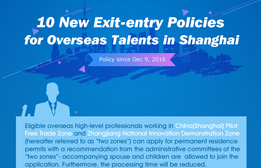Shanghai, forerunner of innovation
Shanghai made significant headway with the development of innovation in the city in 2015.
Among the notable things achieved during the year include the opening of the global science and technology innovation center, the mutual coordination project of Shanghai Free Trade Zone and Zhangjiang National Innovation Demonstration Zone.
Additionally, 10 experimental innovation projects met their proposed schedule, the C919 aircraft was completed and some key semiconductor equipment gained international orders.
“Innovation leads the development of Shanghai,” Han Zheng, Party Secretary of Shanghai believes that innovation leads to the development of the city. He said that Shanghai should make innovation its main driving force to create a more efficient and sustainable economic development environment.
In 2015, the city’s social research and development expenditure took up 3.7 percent of all regional GDP, exceeding 90 billion yuan ($13.81 billion). A total of 396 foreign investment research centers have been set up in Shanghai (the most among cities in China), including 15 newly-established centers.
Shanghai’s general public budget revenue grew 13.3 percent in 2015, reaching 551.95 billion yuan, 19 times more than in 2010. Tertiary industries accounted for 67.8 percent of the value.
Despite the economic downturn, Shanghai still saw a smooth growth rate of 6.9 percent. This suggests that innovation is a dominant driving force for economic development, according to Xiao Lin, director of the Development Research Center of the Shanghai Municipal People’s Government.
Considering the smooth growth rate, many advantages can be seen in Shanghai’s economic development, including the foresight, fast transformation and planning of important technology infrastructures.
The innovation will be carried out in Shanghai’s transform of development strategy, industrial development, economic system reform and talent preferential policies, said Yang Xiong.
Though Shanghai faces huge pressure in economic growth, a total of 1236 outdated production facilities were closed down in 2015, making its total energy consumption decline by 4% compared to 2014.
In addition, Shanghai planned a batch of important science and technological projects in fields of cerebrology and artificial intelligence, and completed some science and technology infrastructure such as Natural Center for Protein Science Shanghai. At the beginning of 2016, Beidou satellite navigation system established six application systems.
Shanghai attached great importance to attracting talent and took a series of measures to entice top graduates and job candidates.
Shanghai had received 234 applications for the permanent residence of overseas high-level talents within six months since July 2015. After the release of new talent preferential policy, the number of applicants increased to 800 percent compared with the previous six months.
According to the policy, overseas talents could apply for permanent residence permit after his or her working visa is more than three year old, with the “recommendation letter of overseas talent working and residence permit”. Before the new preferential talents policy, only foreign experts selected among the “One Thousand Talents Plan” can enjoy the preferential application.
At the same time, a domestic talents attraction policy and system has been gradually established, which provide preferential policies for five kinds of innovation and startup talents.
Since November 2015, more than 2,000 people have reached the demanded score (for the application of permanent residence permit) in Shanghai, and more than 100 people applied for the shortening of transform from temporary residence permit to Hukou (permanent residence permit).
Additionally, Shanghai makes efforts to develop local innovation and startup enterprises, and settled to motivate talents with the research finding revenue. At present, there are 450 start-up centers in Shanghai. Respond to the new talent policy, Shanghai Institute of Materia Media permitted that not less than 70 percent of research finding revenue can belong to the research team.
In 2015, a total of 15 new medicine research findings were transferred successfully, accounting to 800 million yuan in contract, the same as the sum transfer value of the previous five years.
Apart from all these, system innovation is also the priority to Shanghai municipal government.
According to Yang Xiong, mayor of Shanghai, some enterprises may meet all kinds of hurdles when adopting new business mode, such as business permit, export rebates, valuation of high- tech enterprises and industry supervision. Transfer of government function and innovation of governance management became urgent tasks in innovation development.
In 2015, Shanghai cancelled and adjusted 354 administrative examination and approval items, conducted trial implementation of centralized registration and “one address, several business licenses” registration, which largely lowered the startup costs and admittance threshold. A total of 254,000 enterprises registered in 2015, with the new registered capital increased by 67.6 percent.
The integration of finance innovation and science innovation will active local development potential, and provide better services to the country, said Kong Qingwei, Party chief of the Shanghai Financial Service Office.
The transform of innovation systems has spread in many fields, such as education, jurisdiction and intellectual property.
Shanghai will strive to form the basic structure of global science and technology innovation center before 2020, to explore a new innovation way in China, Yang Xiong added.

 Print
Print Mail
Mail




